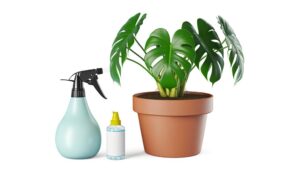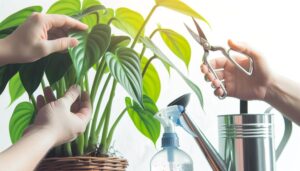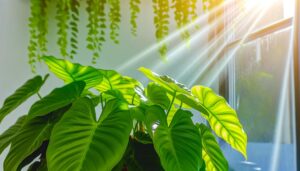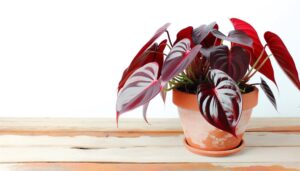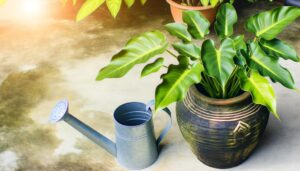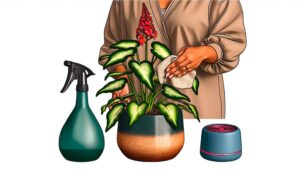Ring of Fire Philodendron Care
The 'Ring of Fire' Philodendron is a distinctive hybrid plant requiring targeted care. It thrives in bright, indirect light and prefers a temperature range between 65-80°F (18-27°C).
Maintain a high humidity level of 60-80% and use well-draining soil with pH 6.0-7.0. Water when the top inch of soil is dry, and strategically feed a 20:20:20 NPK ratio fertilizer every 4-6 weeks.
Pruning and repotting contribute to a clean appearance and robust growth. Be vigilant for pests and diseases, such as aphids and root rot.
Successful propagation utilizes stem cuttings or air layering techniques. A deeper exploration will yield an even healthier plant.
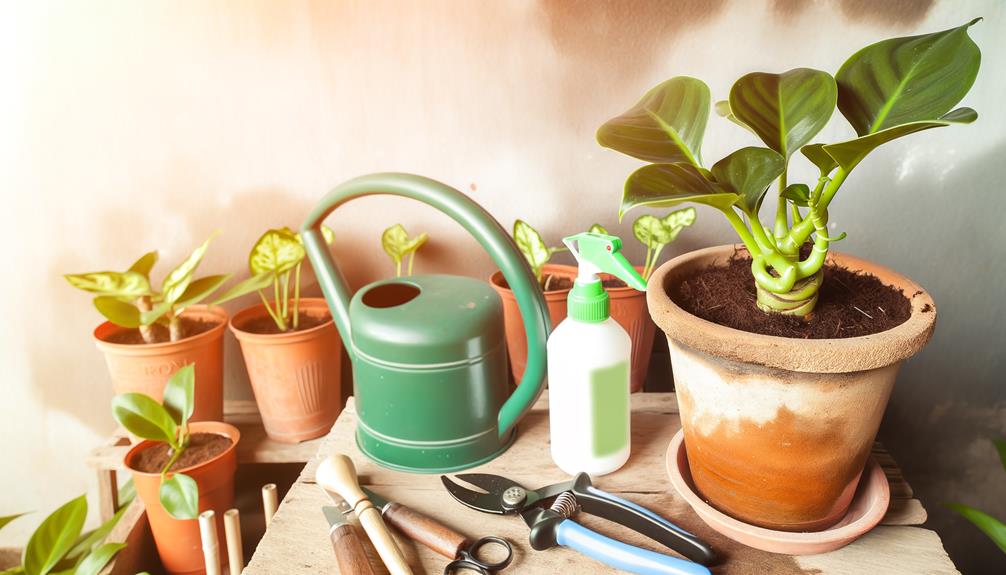
Key Takeaways
- Ring of Fire Philodendron thrives in bright, indirect light and should be shielded from direct sunlight.
- It requires a watering balance where the top inch of soil should be allowed to dry before watering again.
- The plant prefers a temperature range of 65-80°F (18-27°C) and high humidity levels of 60-80% for optimal growth.
- Fertilize every 4-6 weeks with a 20:20:20 NPK ratio and prune regularly for robust growth and clean appearance.
- Propagation techniques include stem cuttings, air layering, division, and leaf bud cuttings.
Understanding 'Ring of Fire' Philodendron
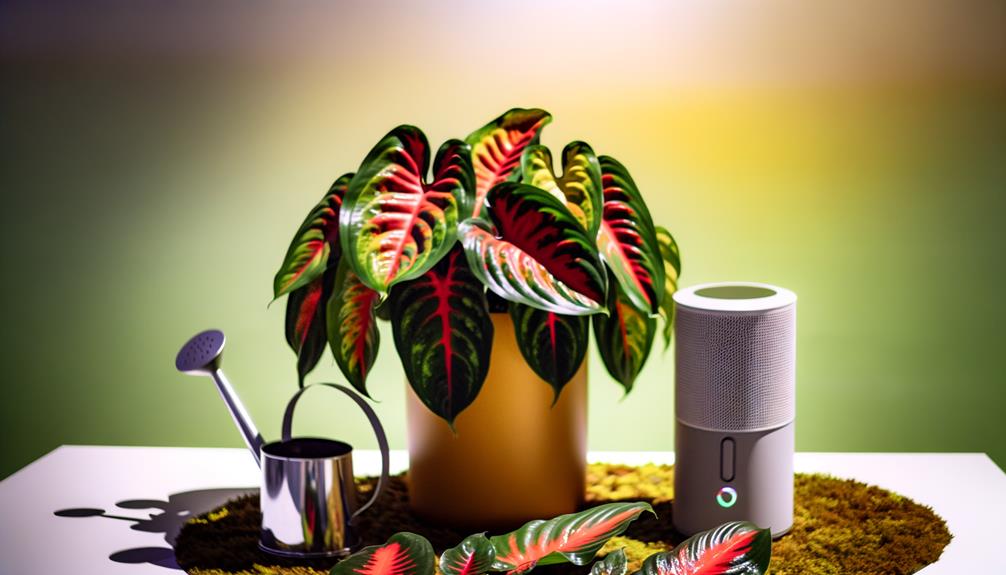
The 'Ring of Fire' Philodendron, scientifically identified as Philodendron 'Ring of Fire', is a distinctive and visually striking variety of tropical plant characterized by its unique leaf patterns and vibrant coloration. This plant, a hybrid originating from the Araceae family, is renowned for its variegated foliage that shifts from dark green to a fiery orange-red.
The elongated leaves feature prominent ridges, contributing to the plant's overall aesthetic appeal. Moreover, it exhibits an active growth pattern and can reach substantial heights, making it an excellent choice for indoor vertical greenery.
Understanding its growth habit, leaf structure, and color variation is essential in providing optimum care and in promoting its health and vitality. This knowledge serves the plant's well-being and enhances the aesthetic value it adds to its environment.
Ideal Lighting Conditions
The Ring of Fire Philodendron, like many tropical plants, has specific lighting necessities that must be met for best growth. It is essential to comprehend these light requirements, especially the need to shield the plant from direct sunlight exposure, which can cause damage.
Adjusting the lighting conditions in accordance with the plant's growth stages is also a key aspect of ensuring a healthy, thriving Philodendron.
Understanding Light Requirements
Understanding the light needs of Ring of Fire Philodendron is crucial for its top growth. This tropical plant thrives best in bright but indirect light, which closely mimics its natural habitat under the canopies of rainforests. It's essential to replicate these conditions to ensure prime photosynthetic activity.
High intensity, direct sunlight may result in photobleaching and leaf scorch, while low light levels can cause reduced growth and variegation loss. Ideal light levels for this species are approximately 200 to 300 foot-candles, which can be achieved using indirect natural light or fluorescent lighting.
Avoiding Direct Sunlight Exposure
Shielding the Ring of Fire Philodendron from direct sunlight proves to be vital in maintaining its vibrant foliage and preventing photobleaching, a condition characterized by the loss of chlorophyll due to excessive light exposure. The plant's photosynthetic apparatus, particularly the chloroplasts, become overstimulated in high light intensities, leading to the degradation of chlorophyll molecules.
As a result, the plant's color fades, its growth rate decreases, and it can even lead to premature death. To ensure peak health and longevity for your Ring of Fire Philodendron, provide a bright but diffused light setting. Avoid placing it near south-facing windows where sunlight is strongest.
Essentially, understanding and implementing these lighting conditions is a vital act of care towards this stunning plant.
Adjusting Lighting for Growth
Consistently adjusting the lighting conditions for your Ring of Fire Philodendron can greatly enhance its growth and overall health. Perfect lighting conditions signify a balance between bright, indirect light and periods of shade.
Exposure to bright, filtered light for about 12-16 hours daily stimulates photosynthesis, promoting efficient nutrient absorption and vigorous growth. However, persistent exposure to intense light can cause leaf burn. Conversely, inadequate light results in stunted growth, poor root development, and decreased importance.
To optimize lighting, consider the plant's natural habit, season, and indoor lighting conditions. Regularly rotate the plant to ensure consistent exposure. Automated systems, such as timers and light sensors, can assist in maintaining best light conditions, providing a systematic approach to enhancing plant wellness.
Watering Needs and Frequency
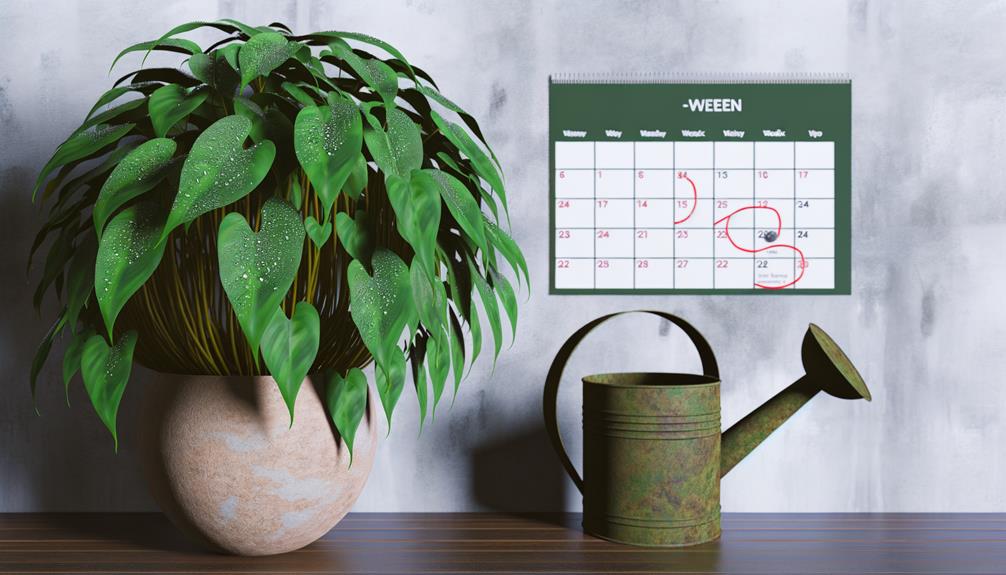
Understanding the watering needs and frequency of the Ring of Fire Philodendron is essential to its successful cultivation.
We will first evaluate the best watering techniques necessary for this species, followed by a discussion on how to recognize signs of underwatering.
This approach will provide a thorough understanding of the plant's hydration requirements and the impact of watering practices on its growth and health.
Optimal Watering Techniques
In the domain of indoor plant care, the Ring of Fire Philodendron requires a delicate balance of moisture and drainage, necessitating a watering regimen that is both consistent and adaptable to environmental variations. This tropical plant thrives best when the top inch of soil is allowed to dry out between watering sessions. Overwatering can lead to root rot, a common issue that can be fatal for your Philodendron.
Here is a detailed breakdown of ideal watering techniques:
| Environment | Topsoil Dryness | Watering Frequency |
|---|---|---|
| High Humidity | 1 Inch | Once every 10 days |
| Moderate Humidity | 1 Inch | Once every 7 days |
| Low Humidity | 1 Inch | Twice a week |
Maintaining this watering schedule can help promote healthy growth and longevity in your Ring of Fire Philodendron.
Recognizing Underwatering Signs
Detecting underwatering signs in your Ring of Fire Philodendron is crucial for ensuring its health and well-being, as this tropical plant's water requirements can fluctuate based on environmental factors.
The initial signs of underwatering often manifest as wilting, followed by yellowing of the leaves. A detailed observation may reveal a curling or browning at the leaf edges, indicating a severe lack of hydration.
Over time, these conditions can lead to a general stunting of the plant's growth. Ensuring regular, adequate watering that aligns with the plant's natural habitat conditions is essential.
It is advisable to maintain a balance, as both overwatering and underwatering can induce stress in the plant, affecting its overall essentialness and longevity. Knowledge of these signs aids effective care, promoting the plant's best growth.
Temperature and Humidity Preferences
For ideal growth, the Ring of Fire Philodendron prefers a temperature range of 65–80°F (18–27°C) and thrives in high humidity conditions, typically around 60-80%.
It is essential to maintain this thermal band as deviations can hinder the plant's metabolic processes and affect overall health. To create a high humidity environment, you can use humidifiers, pebble trays, or group plants together.
Exposing the plant to temperatures below 12°C may cause physiological stress, leading to slowed growth and discoloration of leaves. On the other hand, temperatures exceeding 30°C can cause dehydration and wilting.
Understanding these preferences enables us to create an environment conducive to the plant's growth, contributing to its longevity and aesthetic appeal.
Soil and Potting Requirements
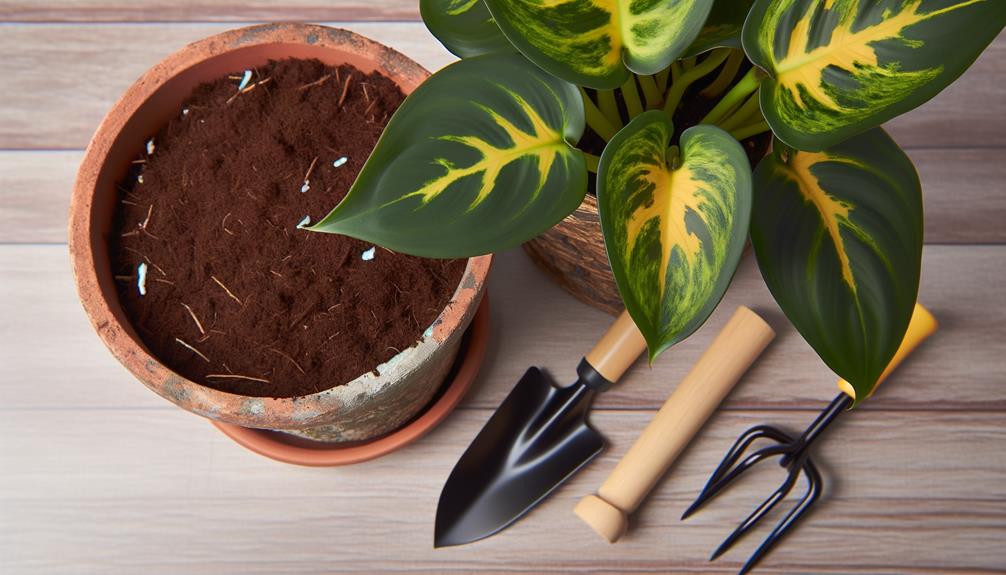
Choosing the correct soil and pot for your Ring of Fire Philodendron greatly influences its growth, health, and overall significance. The plant thrives best in a well-draining soil mix, which allows for adequate water drainage while retaining sufficient moisture. Adding organic matter such as compost or peat moss can enhance the soil's fertility, boosting the plant's nutrient absorption. A pH level between 6.0 and 7.0 is ideal, fostering a balanced environment for root development.
When considering potting, a container with good drainage is essential to prevent waterlogging. The pot should be wide enough to accommodate the plant's extensive root system, allowing for best growth. A lightweight, porous pot material such as terracotta is preferred, as it facilitates better root aeration and moisture regulation.
Fertilization Guide for Vibrant Growth
Implementing a strategic fertilization routine is vital to maintain the vibrant growth and lush foliage of the Ring of Fire Philodendron. This plant thrives when supplied with a balanced liquid fertilizer, ideally with an NPK ratio of 20:20:20, applied every four to six weeks during the growing season.
The application should be reduced during winter to prevent excessive salt build-up in the soil. It is important to dilute the fertilizer to half its strength to prevent leaf burn. Monitoring the plant's response is paramount to adjust the feeding routine as necessary.
Over-fertilization can cause leaf yellowing and root damage, indicating the need for prompt intervention. This meticulous fertilization approach will ensure the Philodendron's prime health and aesthetic appeal.
Pruning and Repotting Tips

In order to maintain ideal growth and shape, regular trimming and timely repotting are essential practices for the health and importance of your Ring of Fire Philodendron. These activities promote robust development, guarantee a clean appearance, and stimulate overall plant health.
Here are four key tips to help you with these tasks:
- Trimming: Remove yellow, brown, or damaged leaves at their base with sanitized trimming shears to prevent disease transmission.
- Frequency: Trim during the growing season, generally between spring and early summer.
- Repotting: Upgrade to a larger pot every 2-3 years, or when the plant becomes root-bound.
- Soil: Use a well-draining, peat-based potting mix during repotting to guarantee ideal nutrient absorption and root aeration.
Common Pests and Diseases
Despite meticulous care, a Ring of Fire Philodendron may occasionally succumb to various pests and diseases, impacting its health and importance. Common pests include aphids, spider mites, and mealybugs. Diseases often stem from fungal or bacterial infections, such as root rot or leaf spot.
The following table provides information on these common issues:
| Pests/Diseases | Symptoms | Treatment |
|---|---|---|
| Aphids | Yellowing, curled leaves | Apply insecticidal soap |
| Spider Mites | Tiny white spots, webbing | Use miticides |
| Mealybugs | Cotton-like masses on stems, leaves | Apply alcohol solution |
| Root Rot | Yellow, wilting leaves | Repot in fresh soil, cut off affected roots |
| Leaf Spot | Brown, black spots on leaves | Apply fungicide, improve air circulation |
Understanding these threats enables better care of your Philodendron, maintaining its beauty and significance.
Propagation Techniques for Philodendron
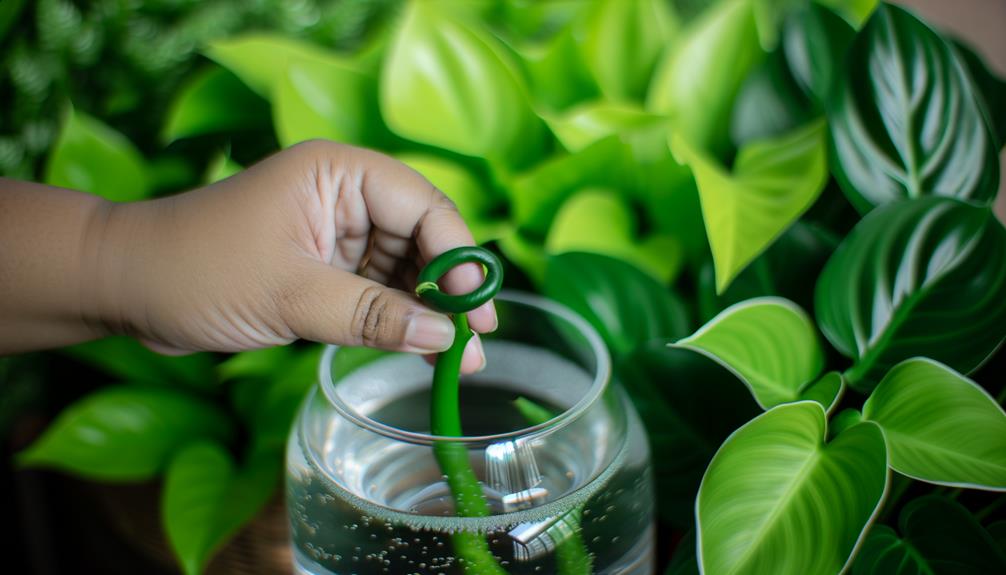
Having understood the common pests and diseases that can affect a Ring of Fire Philodendron, it's equally important to explore the various propagation techniques that can guarantee the plant's healthy growth and longevity.
- Stem Cuttings: This is the most common method. A mature, healthy stem with at least two nodes is cut and placed in water or soil until roots develop.
- Air Layering: This technique involves wounding an area of the stem to stimulate root growth while still attached to the parent plant.
- Division: Mature, well-established plants can be carefully divided at the roots to create new plants.
- Leaf Bud Cuttings: A leaf and its node are cut and planted in a growing medium.
Each method has its advantages and challenges, and choice largely depends on the caregiver's comfort and the plant's condition.
Conclusion
To sum up, the successful cultivation of the 'Ring of Fire' Philodendron demands a thorough understanding of its lighting, watering, temperature, and soil preferences. Proper care also involves attention to fertilization, pruning, repotting, and pest management. Through dedicated propagation techniques, this exotic plant can flourish and enhance indoor spaces with a colorful touch.
Following these guidelines will guarantee the plant's health, showcasing its stunning fiery ring pattern, a proof of the beauty of botanical aesthetics.

